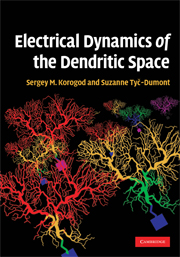Book contents
- Frontmatter
- Contents
- Preface
- 1 Definition of the neuron
- 2 3D geometry of dendritic arborizations
- 3 Basics in bioelectricity
- 4 Cable theory and dendrites
- 5 Voltage transfer over dendrites
- 6 Current transfer over dendrites
- 7 Electrical structure of an artificial dendritic path
- 8 Electrical structure of a bifurcation
- 9 Geography of the dendritic space
- 10 Electrical structures of biological dendrites
- 11 Electrical structure of the whole arborization
- 12 Electrical structures in 3D dendritic space
- 13 Dendritic space as a coder of the temporal output patterns
- 14 Concluding remarks
- Index
- References
2 - 3D geometry of dendritic arborizations
Published online by Cambridge University Press: 03 May 2010
- Frontmatter
- Contents
- Preface
- 1 Definition of the neuron
- 2 3D geometry of dendritic arborizations
- 3 Basics in bioelectricity
- 4 Cable theory and dendrites
- 5 Voltage transfer over dendrites
- 6 Current transfer over dendrites
- 7 Electrical structure of an artificial dendritic path
- 8 Electrical structure of a bifurcation
- 9 Geography of the dendritic space
- 10 Electrical structures of biological dendrites
- 11 Electrical structure of the whole arborization
- 12 Electrical structures in 3D dendritic space
- 13 Dendritic space as a coder of the temporal output patterns
- 14 Concluding remarks
- Index
- References
Summary
Brief historical background
The lack of methods of fixation and the lack of staining techniques seriously handicapped the earlier workers in their observations of nervous tissues during the nineteenth century. The story changed enormously during the last decades of the twentieth century when Golgi found that osmic dichromate fixation followed by silver impregnation gave pictures that could not be achieved by any other method. The enthusiastic description by Ramón y Cajal of the beauty of the successful Golgi preparations depicts for the first time the richness of these histological images:
Against a perfectly translucent yellow ground, you can make out, dotted with dark strands, smooth and thin or rough and thick, black bodies – triangular, star-shaped, shaped like spindles – looking like designs in Indian ink on transparent paper. There is nothing to interpret, nothing to do but watch and take note of this cell with its many moving branches covered in crystals, whose movements encompass a remarkably large area; this smooth even fibre which, originating in the cell, sets off from it to cover enormous distances …
The gifted hand of Ramón y Cajal produced the first seminal book on nervous systems proposing prophetic views on the functions of dendritic arborizations (Ramón y Cajal, 1911). But the lengthy and elaborate descriptions of Golgi preparations discouraged the students who were frustrated with this type of investigation and, influenced by the new results of local electrical stimulation, tended to devote themselves to the new promising approach of electrophysiology.
- Type
- Chapter
- Information
- Electrical Dynamics of the Dendritic Space , pp. 13 - 36Publisher: Cambridge University PressPrint publication year: 2009



